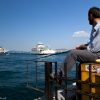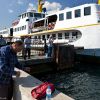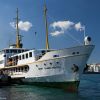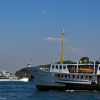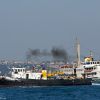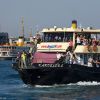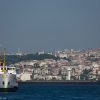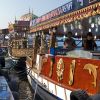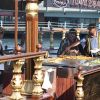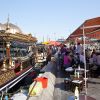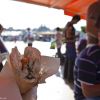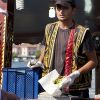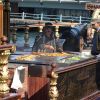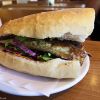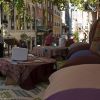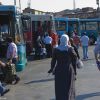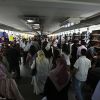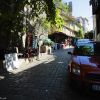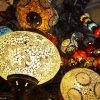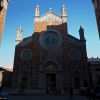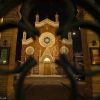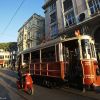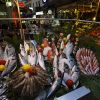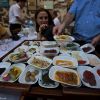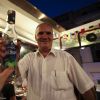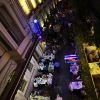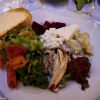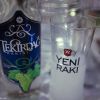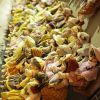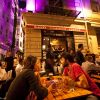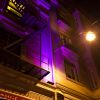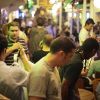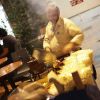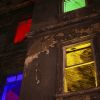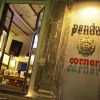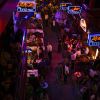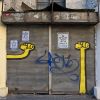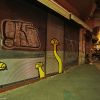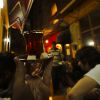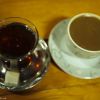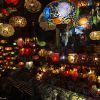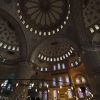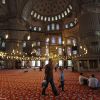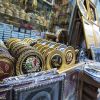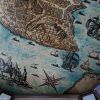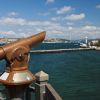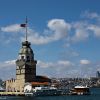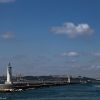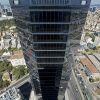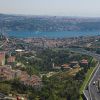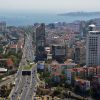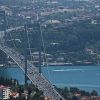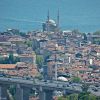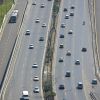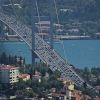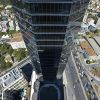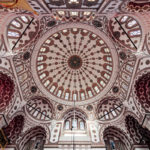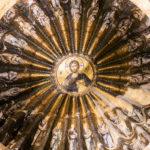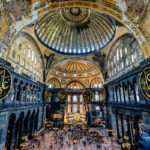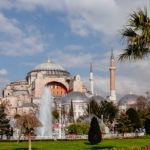Late Summer at Bosporus
Beside spring also late summer is one of the most attractive travel seasons to have a closer look at the Bosporus pearl, as the climatic mix of sun, clouds and fresh breezes coming from the Mediterranian sea is a perfect background to soak up Istanbul’s attitude towards life at daytime as well as at night like a sponge.
The Bosporus waters were slightly choppy that Thursday morning. As every day around Galata Bridge there are dozends of people are tied up again trying to untangle their fishing line, which just clashed with the neighbouring line a few seconds ago. Unbelievable but true, the catch along the Bosporus sealine is everything but bad. That’s the very same reason why Salih is sitting on quay wall of the terminal of the ferries departing to Üsküdar since 8:00 in the morning. It seems as if the buzzing engines of the Vapurs passing by every minute don’t really impress both, neither Salih nor the fish. Loaded with bread the fishhook is flying into the water, and often it’s coming back again having caught a finned sea animal.
A few meters away, where the central bus station Iskeler meets the Galata Bridge, the fishes are already encountering their fate, that is becoming grilled. Well, the fish offered there wasn’t caught in the Bosporus waters for sure, as all the fishermen are preferring to eat the fish they were wrenching from the sea themselves. The boats mooring next to the pier are literally big swimming walkable hearths, grilling tons of fish to the rhythm of the washing waves. The up and down has an effect on the taste, they say ;-) Wearing traditional clothing such as Ray-Ban aviator glasses, the Turkish chefs are offering one of Istanbul’s tastiest delicacies: Balık Ekmek, grilled fish in bread. Depending on the grill boat that is a more or less high in bones and oniony experience for your taste buds, which has to be drowned in stickily-sweet Uludağ lemonade or a refreshing Ayran yoghurt drink.
Depending on taste you can add some lime juice, that is in the bottles standing on every table. The best Balık Ekmek stall is located in the lower level of Galata Bridge, which is more or less a small pedestrian area. Already the first stall at the Eminönü end and on the Bosporus side offers the best mix of salad, almost boneless fish and of course price. Not to mention the great view on the bustling harbour.
I just love to visit Hamams: first cathartic sweating followed by a powerful massage on the hot stone, then the scrub and endless bathing. The feeling when walking back home, being totally relaxed and having a skin as soft as a newborn child, is just great. Of course also in Istanbul there is a chance to have this experience, and the range of Hamams is wide. You’ll surely stumble across Istanbul’s most advertised bath the Cağaloğlu Hamamı (pronounced: Dsha’alolu Hamame), impressing with its 300 year existence and the marble interior.
After having paid two visits, it’s time to have a say about the Cağaloğlu. Unfortunately that Hamam is vastly overpriced. For a 10-minute massage and a less than 2 minutes lasting scrub you have to pay more than 40 Euros, which get more and more inflated in the course of the bath to boot. The peeling glove and the final tea/coffee/whatever are as much as excluded as the Baksheesh for massager and steward. And without having paid Baksheesh they won’t let you go. “Surprisingly” only tourists are encountering this fate… Quickly the former 40 Euro become 50 or even 60, which is quite a high price for a suchlike streamlined bathing procedure. When you’re the only guest, then nobody is under pressure of time. Becoming treated like bulk freight or a piece of wood though, is thought-provoking…
Beyoğlu is the centre of European Istanbul. When speaking out this word, then in particular the neighbourhood between Galata Bridge and and hude Taksim square is meant. Like a big python the wide shopping mile İstiklâl is snaking its way through the Art Nouveau houses of Beyoğlu, connecting the area around the Golden Horn with Istanbul’s most important square. The bustle starts in the evening hours, then the narrow cute historical streets are easily outstripping all shoe stores, men’s outfitters and cathedrals of consumption, then Beyoğlu turns into a big open-air communication hotspot, having several bars and restaurants involved. That vibe that makes you feel good and homelike instantly, and if that is completed with a culinary highlight in terms of seafood, then you don’t want to leave Istanbul.
Speaking of fish & co., Istanbul’s best seafood is served in the countless
Apropos Fisch & Co., das wohl beste Seafood bekommt man in den zahlreichen Restaurants des Balık Pazarı, was übersetzt Fischmarkt bedeutet. Hier gibt es alles: gefüllte Muscheln, frittierte Muscheln, Muscheln in Oliven-Knoblauch-Öl, Shrimps, Hummer, Kalamari und auf den Punkt gegrillte Dorade oder Wolfsbarsch. Natürlich alles fangfrisch. In der sich anschließenden Nevizade Gasse kann man einer weiteren Istanbuler Spezialität fröhnen: Meze; kleine Appetithappen und Vorspeisen, die übrigens nur dann Meze genannt werden, wenn dazu Rakı gereicht wird. Letzterer wird übrigens “Rake” ausgesprochen und kommt zur Freude der Leber auch schon mal in Krügen daher… Meze ansich sind z.B. in Knoblauch und Essig eingelegte rote Bete, oder in tomatiertes Olivenöl eingelegte Anchovis, oder eingelegte Artischocke – ach, es gibt tausende Varianten dieser kleinen Köstlichkeiten. Und jede einzelne ist es Wert gekostet zu werden.
Es ist Ramadan. Nicht alle Türken machen dieses Prozedere mit, der Großteil aber hält sich ans Fasten. Das merkt man nicht zuletzt am Straßenverkehr, wenn abends alle total genervt und gereizt vom Hunger einfach nur noch nach Hause wollen. Auch die Notaufnahmen der Hospitäler haben mehr zu tun. Dinge wie Dehydratation, Kreislauf-Kollaps, Unterzuckerung und Überfressen gehören dann leider immer zur Tagesordnung. In den meisten Restaurants wird während dieser Zeit kein Alkohol ausgeschenkt, auch nicht nach Sonnenuntergang. Und erst recht nicht an Orten wo sich in unmittelbarer Nachbarschaft eine Moschee befindet.
Die wohl interessanteste Begegnung mit dem Ramadan steht dem Mitteleuropäer allerdings des nächtens bevor, wenn zwischen 3 und 4 Uhr der Trommler durch die Gassen zieht und sowohl mit Paukenschlägen als auch Gebrüll die Leute weckt, um sich vor der Morgendämmerung noch etwas für den Tag anzufressen und danach dann wieder zu Bett zu gehen. Manchmal allerdings übertreibt der Kerl auch ein bisschen und drischt derart kräftig auf die Pauke, dass in seine Planübererfüllung diverse Alarmanlagen der umher stehenden Autos einstimmen.
Für die Dauer des Ramadans ist zwischen den Minaretten vieler Istanbuler Moscheen eine spezielle Leuchtschrift aufgespannt und im Innenhof der größeren Gotteshäuser herrscht sogar ein reges weihnachtsmarktartiges Treiben. Wer plant während der Fastenzeit Bauten wie die Süleymaniye oder aber Sultan Ahmet Moschee in architektonischer Reinstform sehen zu können, der irrt. Die Innenhöfe sind voll mit diversen Buden, die Minarette leider teilweise eingerüstet und besagte Leuchtschrift hängt über dem Gebäude.
Viele Türken müssen generell auch Samstags arbeiten. Kurz nach Feierabend sammelt mich meine Freundin Kumru in Besiktas ein. In einem völlig überfüllten Bus geht es Richtung Levent, dem Finanz- und Hochhausdistrikt Istanbuls. Dort befinden sich die erst kürzlich fertig gestellten Tat Towers, an deren Eingangstür uns ihr Vater empfängt. Es geht in das 30. Stockwerk und gut 200m nach oben. Vom ohnehin schon hoch gelegenen Leventer Hügel eröffnet sich nun eine völlig neue Perspektive – Istanbul im Panoramaformat und von oben.
Von oben erkennt man das Wirrwarr der Straßen gut, vor allem die großen 6- bis 8-spurigen Adern, auf denen sich die Autos zu hunderten aufreihen, um über die südliche, erste Bosporus-Brücke fahren zu können. Auch Sultanahmet, den Galataturm, die Minarette von Hagia Sophia und Blauer Moschee kann man im blauen Dunst erkennen, ja sogar die noch weiter weg gelegenen Inseln im Marmarameer kann man in der Ferne ausmachen. Die Tat Towers sind aktuell Istanbuls höchste Türme. Ein gewagter Bau für ein Erdbebengebiet. So auch das Marmara Projekt, eine unterseeische Bahnverbindung zwischen West und Ost, zwischen Sultanahmet und südlichen Üsküdar.
